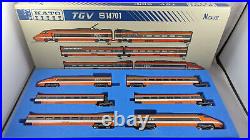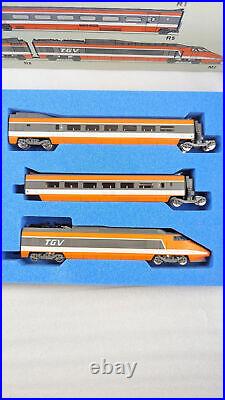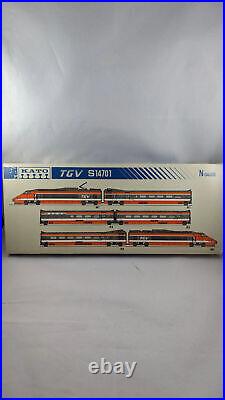KATO French TGV S14701 (1983) (Hard to spot) (Very good condition)







KATO French TGV S14701 (1983) (Hard to spot) (Very good condition). KATO – French TGV S14701. Used, IN VERY GOOD CONDITION for its age (1983). Set : one powered locomotive (M1) 14701, one dummy locomotive (M2) 14701, three passenger carriages (R1) 14703, (R5) 14706, (R8) 14707 and one bar (R4) 14705. The TGV (French: Train à Grande Vitesse, “high-speed train”) is France’s intercity high-speed rail service, operated by the SNCF, the national rail operator. It was developed in the 1970s by GEC-Alsthom and the SNCF. Originally designed as turbotrains to be powered by gas turbines, TGV prototypes evolved into electric trains with the 1973 oil crisis. Following the inaugural service between Paris and Lyon in 1981 on the LGV Sud-Est (LGV for Ligne à Grande Vitesse; “high-speed line”), the network, centered on Paris, has expanded to connect main cities across France (Marseille, Lille, Bordeaux, Strasbourg, Rennes) and in adjacent countries on combinations of high-speed and conventional lines. A TGV test train set the record for the fastest wheeled train, reaching 574.8 km/h (357.2 mph) on 3 April 2007. In mid-2011, scheduled TGV trains operated at the highest speeds in conventional train service in the world, regularly reaching 320 km/h (200 mph) on the LGV Est, LGV Rhin-Rhône, and LGV Méditerranée. Trains running from Paris to Marseille and Strasbourg can also reach 350 km/h (220 mph). According to Railway Gazette International reports in 2007, the world’s fastest scheduled rail journey was a start-to-stop average speed of 279.4 km/h (173.6 mph) between the Gare de Champagne-Ardenne and Gare de Lorraine on the LGV Est, not surpassed until Railway Gazette International’s 2013 reported average of 283.7 km/h (176.3 mph) express service on the Shijiazhuang to Zhengzhou segment of China’s Shijiazhuang-Wuhan high-speed railway. The commercial success of the first LGV, the LGV Sud-Est, led to an expansion of the network to the south (LGV Rhône-Alpes, LGV Méditerranée, Contournement Nîmes – Montpellier), and new lines in the west (LGV Atlantique, LGV Bretagne-Pays de la Loire and LGV Sud Europe Atlantique), north (LGV Nord and LGV Interconnexion Est), and east (LGV Est). Eager to emulate the TGV’s success, neighboring countries Italy, Spain, and Germany developed their own high-speed rail services. The TGV system itself extends to neighboring countries, either directly (Italy, Spain, Luxembourg, Germany and Switzerland) or through TGV-derivative networks linking France to Belgium, Germany, and the Netherlands (Thalys), as well as France and Belgium to the United Kingdom (Eurostar). Several future lines are planned, including extensions within France and to surrounding countries. Cities such as Tours have become part of a “TGV commuter belt” around Paris.
